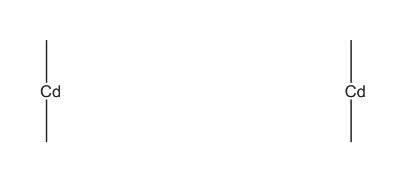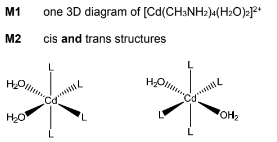Question

(b) Cadmium forms the two ions, Cd22+ and Cd2+. The electronic configuration of cadmium in these ions is shown.
● [Kr] 4d105s1
● [Kr] 4d10
Use this information to explain why cadmium is not a transition element.
octahedral complexes.
equilibrium 1 \([Cd(H_{2}O)_{6}]^{2+} + 4CH_{3}NH_{2} \rightleftharpoons [Cd(CH_{3}NH_{2})_{4}(H_{2}O)_{2}]^{2+} + 4H_{2}O\)ΔHθr = –57kJmol–1
(ii) Complete the three-dimensional diagrams to show the isomers of [Cd(CH3NH2)4(H2O)2]2+.
Use L to represent CH3NH2 in your diagrams.

(d) (i) State what is meant by the term stability constant.

EDTA4– is a polydentate ligand. When a solution of EDTA4– is added to [Cd(H2O)6]2+ a new complex [CdEDTA]2– is formed.
The values for the stability constants for two Cd2+ complexes are shown.

(iii) A solution containing equal numbers of moles of CH3NH2 and EDTA is added to [Cd(H2O)6]2+.
Predict which complex is formed in the larger amount. Explain your answer.
(e) Methylamine is a Brønsted-Lowry base.
Write an equation showing how methylamine dissolves in water to give an alkaline solution.
(f) Methylamine is a useful reagent in organic chemistry.
(i) Write an equation for the reaction of ethanoyl chloride with methylamine.
(ii) Methylamine also reacts with propanone to form compound P as shown.

Deduce the type of reaction shown here.
Answer/Explanation
Answer: (a) 
(b) both cadmium ions have full d subshells
(c)(i) donates one lone pair to the central metal ion
(c)(ii)

(d)(i) equilibrium constant for the formation of a complex ion in solution / solvent
(d)(ii)

(d)(iii) [CdEDTA]2– and larger Kstab value
(e) CH3NH2 + H2O ⇌ CH3NH3+ + OH–
(f)(i) CH3COCl + CH3NH2 → CH3CONHCH3 + HCl
M1 Correct formulae of CH3COCl or CH3CONHCH3
M2 rest of the equation
(f)(ii) condensation or addition-elimination
Question
Sodium oxide, Na2O, is a white crystalline solid with a high melting point.
(a) Write an equation for the reaction of sodium with oxygen, forming sodium oxide.
Include state symbols.
(b) Explain why sodium oxide has a high melting point.
(c) When sodium oxide reacts with water an alkaline solution is obtained.
(i) Explain why the solution obtained is alkaline. You should use the Brønsted-Lowry theory
of acids and bases in your answer.
(ii) Calculate the pH of the solution obtained when 3.10g of sodium oxide are added to 400cm3
of water.
(d) Use the data below, and other suitable data from the Data Booklet, to calculate the lattice
energy of sodium oxide, ΔHθlatt Na2O(s).

(e) State how ΔHθlatt Na2S(s) differs from ΔHθlatt Na2O(s).
Indicate this by placing a tick (✓) in the appropriate box in the table.

Answer/Explanation
Answer: (a) 4Na(s) + O2(g) → 2Na2O(s)
balanced with all formulae correct
state symbols
(b) giant ionic
strong bond / attraction between
AND
positive and negative ions / anions and cations / Na+ and O2– / oppositely charged ions
(c)(i) the reaction produces sodium hydroxide / hydroxide ions / OH– ions
the hydroxide ions can receive / accept H+ ions / protons
(c)(ii) Calculation of Na2O moles 3.10g / 62 OR 0.05
Calculation of [OH–] 0.05 × (2 / 0.400) = 0.25 mol dm–3
Calculation of pH –log 0.25 = 0.60
14 – 0.60 = 13.40
(d) use of (2 × 109) or 218 and (2 × 494) or 988
use of (0.5 × 496) or 248
use of 416, 142, 844
evaluation of expression correctly
∆Hlat = –416 – (2 × 109) – (0.5 × 496) – (2× 494) – (–142 + 844) = –2572
(e) the lattice energy of Na2S is less exothermic
the sulfide ion is larger than the oxide ion / S2– larger than O2 / ionic radii quoted 0.184 nm and 0.140 nm
AND less attraction (between the ions)/bonds are weaker